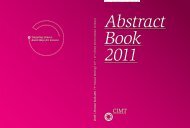Abstract Book 2010 - CIMT Annual Meeting
Abstract Book 2010 - CIMT Annual Meeting
Abstract Book 2010 - CIMT Annual Meeting
Create successful ePaper yourself
Turn your PDF publications into a flip-book with our unique Google optimized e-Paper software.
016 van Nuffel | Therapeutic vaccination<br />
T cell specificities after vaccination of melanoma patients with<br />
mRNA loaded DC<br />
An MT Van Nuffel 1 , Daphné Benteyn 1 , Sofie Wilgenhof 1,2 , Jurgen Corthals 1 , Carlo Heirman 1 , Bart Neyns 2 ,<br />
Kris Thielemans 1 and Aude Bonehill 1<br />
1 Laboratory of Molecular and Cellular Therapy, Vrije Universiteit Brussel, Brussels, Belgium<br />
2 Department of Medical Oncology, Universitair Ziekenhuis Brussel, Brussels, Belgium<br />
52<br />
The incidence of melanoma doubles every 10 years.<br />
The use of full-length tumor associated antigens<br />
(TAAs) to load dendritic cells (DCs) is proposed<br />
to improve DC based immunotherapy because<br />
this should allow vaccination irrespective of the<br />
patient’s HLA-type and stimulation of a broad spectrum<br />
of TAA-recognizing T cells.<br />
Our objective was to investigate the in vivo stimulatory<br />
potency of DCs loaded by electroporation with<br />
defined, full-length TAA-encoding mRNA. Defined<br />
mRNA was chosen as antigen carrier because it can<br />
be modified to enhance the antigen presentation by<br />
DCs to both CD8+ and CD4+ T cells. The exact T<br />
cell specificities of vaccine stimulated T cells were<br />
analyzed.<br />
Histologically confirmed AJCC stage IV melanoma<br />
patients included in a phase I clinical study<br />
donated a skin biopsy one week after the last of<br />
four biweekly DC-vaccines. Vaccination occurred<br />
with an equal mix of TriMix-DC (i.e. DCs matured<br />
using constitutive active TLR4, CD40L and CD70<br />
mRNA) co-electroporated with mRNA encoding<br />
gp100, tyrosinase, Mage-C2 or Mage-A3 fused to<br />
the HLA-class II targeting sequence of DC-Lamp.<br />
Skin biopsies were taken 72h after induction of the<br />
delayed type hypersensitivity (DTH) response by<br />
intradermal injection of a small amount of vaccine<br />
DCs. DTH-infiltrating lymphocytes (DIL) were cultured<br />
during 2,5 weeks in the presence of 100 IU/<br />
ml IL-2. The DIL were re-stimulated overnight by<br />
autologous EBV-B cells electroporated with TAA<br />
mRNA. Activated T cells were detected by both<br />
CD137 upregulation in flow cytometry and cytokine<br />
secretion (IFN-γ and TNF-α) using a cytokine<br />
bead assay. Once T cells specific for a vaccine<br />
antigen were found, the recognized epitope was determined<br />
using autologous EBV-B cells loaded with<br />
overlapping peptides covering the TAAs. The HLA<br />
restriction was assessed by allogeneic EBV-B cells<br />
expressing relevant HLA-types and vaccine TAA.<br />
This way, we found CD8+ and CD4+ T cells<br />
specific for the previously unidentified epitopes<br />
RTCQCSGNF and YPPLHEWVLREG, derived<br />
from the tumor antigens tyrosinase and Mage-A3,<br />
respectively. These epitopes were presented respectively<br />
in the less common HLA-B57 and the<br />
common HLA-DQB1*05. In vivo stimulation of the<br />
CD8+ T cells by the TriMix-DCs was confirmed by<br />
the analysis of blood samples obtained pre- and<br />
postvaccination.<br />
In conclusion, vaccination of melanoma patients<br />
with mRNA loaded DCs leads to in vivo stimulation<br />
of CD8+ and CD4+ T cells recognizing previously<br />
unknown epitopes presented in both common and<br />
less common HLA-types. This finding underscores<br />
the broadness of the induced T cell response and<br />
thereby the strength of using mRNA loaded DCs.<br />
On the other hand, it shows that DC-therapy is no<br />
longer solely suitable for a selected population with<br />
a certain HLA-type but can be beneficial for all patients.



